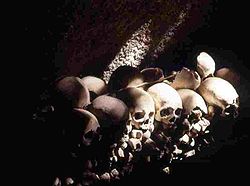
Fontanelle cemetery
Encyclopedia

Naples
Naples is a city in Southern Italy, situated on the country's west coast by the Gulf of Naples. Lying between two notable volcanic regions, Mount Vesuvius and the Phlegraean Fields, it is the capital of the region of Campania and of the province of Naples...
is a charnel house
Charnel house
A charnel house is a vault or building where human skeletal remains are stored. They are often built near churches for depositing bones that are unearthed while digging graves...
, an ossuary
Ossuary
An ossuary is a chest, building, well, or site made to serve as the final resting place of human skeletal remains. They are frequently used where burial space is scarce. A body is first buried in a temporary grave, then after some years the skeletal remains are removed and placed in an ossuary...
, located in a cave in the tuff
Tuff
Tuff is a type of rock consisting of consolidated volcanic ash ejected from vents during a volcanic eruption. Tuff is sometimes called tufa, particularly when used as construction material, although tufa also refers to a quite different rock. Rock that contains greater than 50% tuff is considered...
hillside in the Materdei section of the city. It is the source of a fascinating chapter in the folklore of the city. By the time the Spanish moved into the city in the early 16th century, there was already concern over where to locate cemeteries, and moves had been taken to locate graves outside of the city walls. Many Neapolitans, however, insisted on being interred in their local churches. To make space in the churches for the newly interred, undertakers started removing earlier remains outside the city to the cave, the future Fontanelle cemetery. The remains were interred shallowly and then joined in 1656 by thousands of anonymous corpses, victims of the great plague of that year.
Sometime in the late 17th century—according to Andrea De Jorio
Andrea De Jorio
Andrea De Jorio was an Italian antiquarian who is remembered today among ethnographers as the first ethnographer of body language, in his work La mimica degli antichi investigata nel gestire napoletano, 1832...
, a Neapolitan scholar from the 19th century, great floods washed the remains out and into the streets, presenting a grisly spectacle. The anonymous remains were returned to the cave, at which point the cave became the unofficial final resting place for the indigent of the city in the succeeding years—a vast paupers' cemetery. It was codified officially as such in the early 19th century under the French rule of Naples
Joachim Murat
Joachim-Napoléon Murat , Marshal of France and Grand Admiral or Admiral of France, 1st Prince Murat, was Grand Duke of Berg from 1806 to 1808 and then King of Naples from 1808 to 1815...
. The last great "deposit" of the indigent dead seems to have been in the wake of the cholera epidemic of 1837.
Then, in 1872, Father Gaetano Barbati had the chaotically buried skeletal remains disinterred and catalogued. They remained on the surface, stored in makeshift crypts, in boxes and on wooden racks. A spontaneous cult of devotion to the remains of these unnamed dead developed in Naples. Defenders of the cult pointed out that they were paying respect to those who had had none in life, who had been too poor even to have a proper burial. Devotees paid visits to the skulls, cleaned them—"adopted" them, in a way, even giving the skulls back their "living" names (revealed to their caretakers in dreams). An entire cult sprang up, devoted to caring for the skulls, talking to them, asking for favors, bringing them flowers, etc. A small church, Maria Santissima del Carmine, was built at the entrance.
The cult of devotion to the skulls of the Fontanelle cemetery lasted into the mid-20th century. In 1969, Cardinal Ursi
Corrado Ursi
Corrado Ursi was an Italian prelate of the Roman Catholic Church. He served as Archbishop of Naples from 1966 to 1987, and was created a cardinal in 1967, given the titular church of San Callisto.-Biography:...
of Naples decided that such devotion had degenerated into fetishism and ordered the cemetery to be closed. It has recently undergone restoration as a historical site and may be visited.

